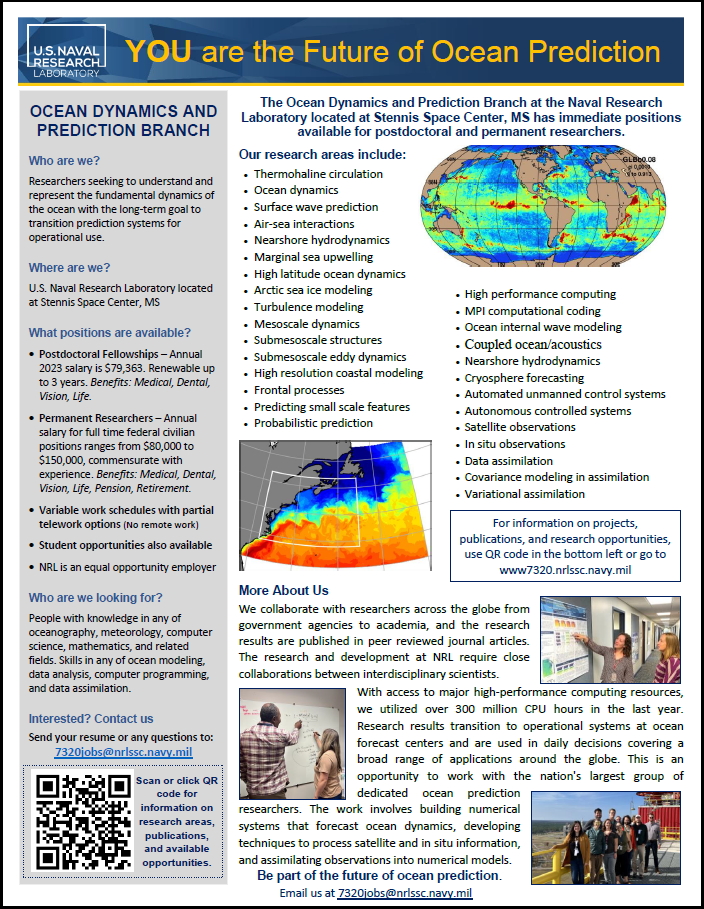
|
|
| ||
Available Opportunities |
||
|
The Ocean Dynamics and Probabilistic Prediction Branch of the Naval Research Laboratory is located at Stennis Space Center, MS. We currently have employment opportunities for postdoctoral fellowships, permanent civil service positions, visiting scientists, and students in a variety of research areas. The type of appointment is dependent upon the qualifications and interests of the successful candidates.
Postdoctoral Programs Employment opportunities for postdoctoral programs are through the National Research Council (NRC) and the American Society for Engineering Education (ASEE). NRC reviews applications on 1 February, 1 May, 1 August, and 1 November every year, and ASEE reviews applications whenever they are received. Applicants to NRC or ASEE must be U.S. citizens. We are looking for postdoctoral candidates who have an interest in conducting basic research in the areas of data assimilation; global, mesoscale, and aerosol modeling; nowcasting, data fusion, and satellite and artificial intelligence applications for meteorology and oceanography.A list of current postdoctoral opportunities can be found HERE. Civil Service Positions NRL offers its civilian employees a flexible work schedule, competitive salaries with locality pay, world-class research facilities that include state-of-the-art satellite processing and computing resources, and the opportunity to work with teams of talented and accomplished scientists. The actual starting salary is based on the education and experience of each candidate. Unlike most federal labs, NRL has the flexibility to create new civil service positions as funding permits or requires. Applicants should be U.S. citizens and have a B.S., M.S. or Ph.D. degree, or equivalent experience, in meteorology, physical science, computer science or an engineering field. Information about the many benefits of working for the Naval Research Laboratory and the special programs provided by the Laboratory can be found on the NRL D.C. Human Resources Web Pages.Summer Faculty Program The Office of Naval Research (ONR) Summer Faculty Program provides resident research opportunities for research or teaching faculty at U.S. colleges and universities. Please visit the linked website for contact information where you can direct further inquiries. Additionally, ONR Global can arrange and may support short-term visits to NRL for international scientists working on problems of interest to the Navy, who might not otherwise be able to make the visit.Student Employment ONR offers several different student opportunites, including student employment opportunites through the STEM Student Emplyment Program (SSEP). This program is a direct hire authority for undergraduate and graduate students enrolled in scientific, technical, engineering, or mathematics majors.Summer Student Internships ONR offers several different student opportunites, including summer student internships. The Naval Research Enterprise Intern Program (NREIP) provides financially supported summer internships at Navy laboratories to undergraduate and graduate students. And the Science and Engineering Apprenticeship Program (SEAP) provides financially supported summer internships to local high school students through ONR’s. |
This is an Official U.S. Navy Web Site
| U.S. Naval Research Laboratory - Privacy Policy |
